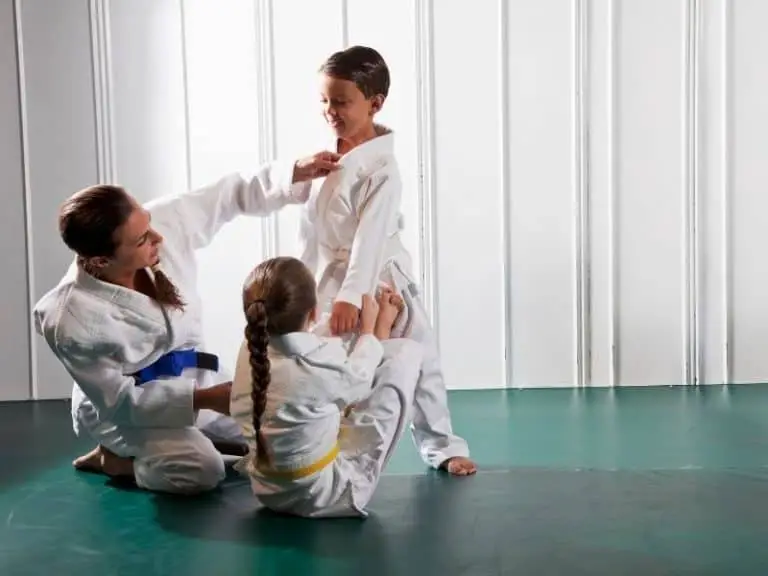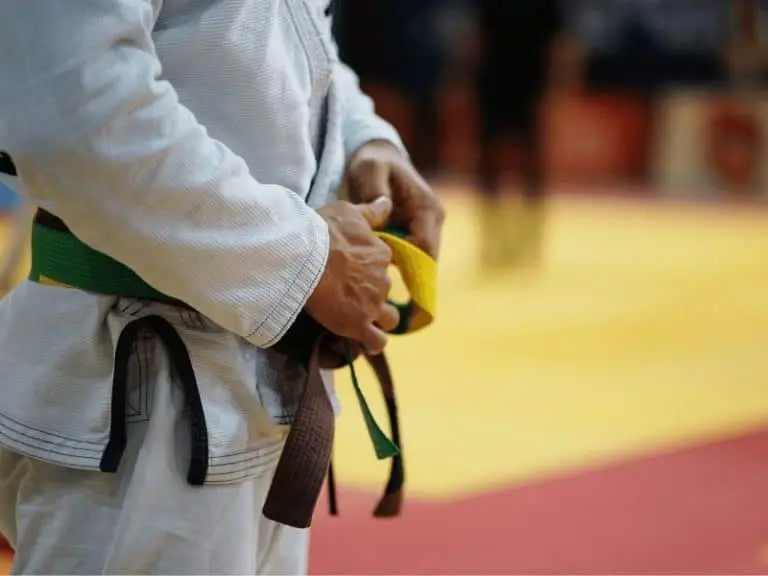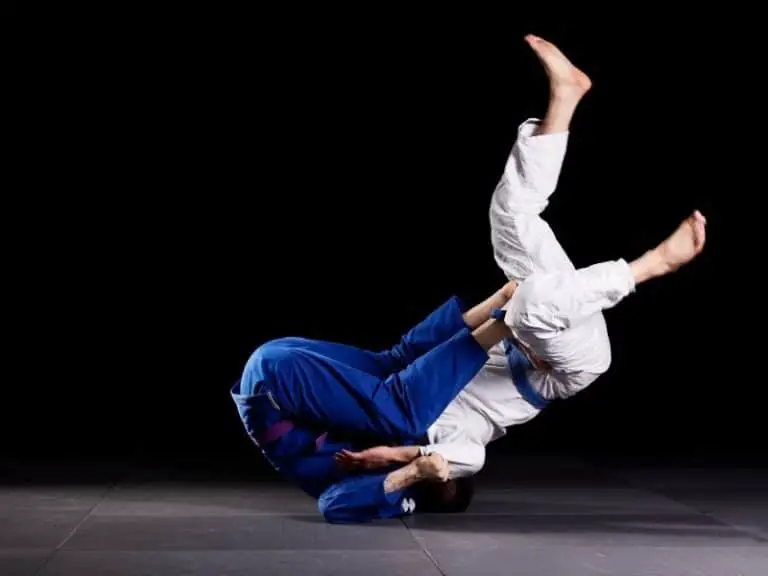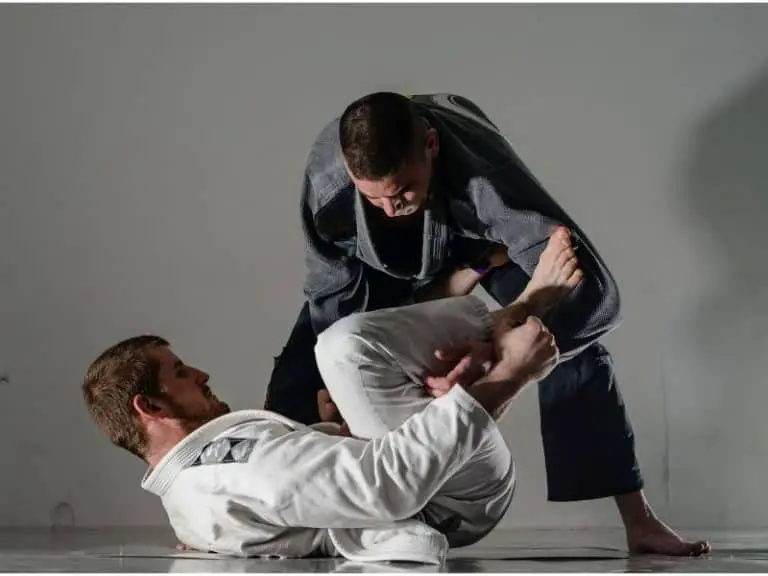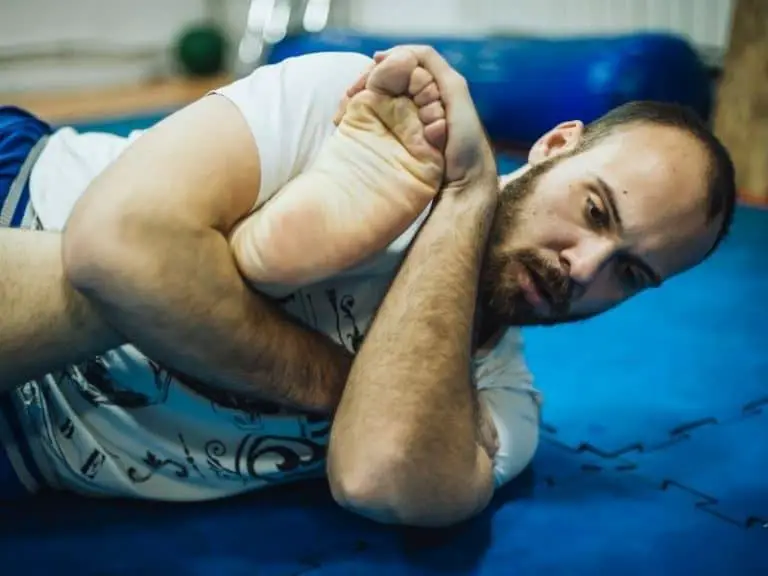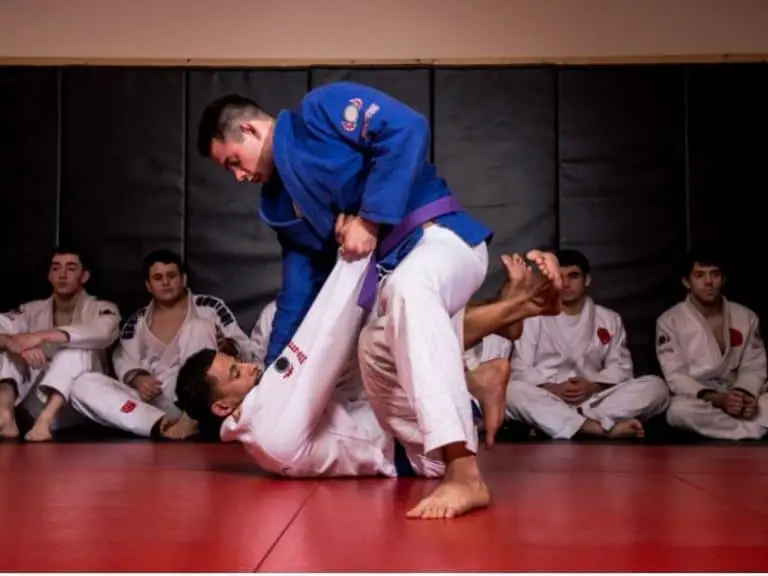Jiu Jitsu 101: How Dangerous and How to Avoid Injury
Injuries are common in sports including Brazilian Jiu Jitsu. In one study, the prevalence of injuries in the sport is 9.2 out of 1000 matches. While it may seem small, you don’t know what will happen in the mat. So in this article we will discuss how to prevent or avoid injuries in BJJ. Also, we will answer does Jiu Jitsu ruin your body?
Jiu Jitsu ruins your body if you do not have any safety measures to prevent injuries. This is because Jiu Jitsu is a sport. Most if not all sport have risks for injuries. Injuries from Jiu Jitsu usually comes from using the moves incorrectly, and training too much.
As you can see, Jiu Jitsu can ruin our body if we don’t practice it with caution. So in this article, we will not just discuss if Jiu Jitsu can hurt our body, we will also discuss why it can be bad and how to prevent any injury from happening.

Does Jiu Jitsu Ruin your Body?
Jiu Jitsu can ruin your body if you do not practice it with caution. This means that if you practice Jiu Jitsu without regard for recovery, or you are rolling without studying the proper form, it can cause severe injuries. But with safety practices, the likelihood of injuries will be significantly lower.
There are some people who have good practices and took up Jiu Jitsu even at an old age. In class pictures, you can see people in their 40s or 50s in the class.
This is because while Jiu Jitsu can be really dangerous that can ruin your body, with proper practice and taking care of your body, you can prevent injuries from happening.
The likelihood of having injuries from Brazilian Jiu Jitsu is only at 1% (0.92%) which came from a study from the Orthopaedic Journal of Sports Medicine[1].
The most common reason why these happen is because of incorrect movements and not taking rest seriously. So this must be a wake up call to people practicing or planning to start studying Jiu Jitsu.
You can get hurt while doing Jiu Jitsu. There are many reasons why this may happen but mostly because of improper form, another is that you are not taking enough rest and recovery time. It may also come from your rolling partner which may use brute force to lock you down.
Why Jiu Jitsu can be Bad to your Body?
Jiu Jitsu can be Bad to your body because it is a grappling sport. There are numerous takedowns and throws that can cause severe injury to a person. That is why proper form, safety gears and basics are necessary. Basics such as how to fall properly might seem simple but will help prevent any injuries.
One of the reason that makes Jiu Jitsu bad for our body is the basics.
It must not be taken lightly. What is the proper hold. You need to take note of these.
The proper angle, strength, when to tap out, takedowns and how to fall properly.
It might seem basic but that is what we want. We want our body to know the best practices to prevent injuries.
Another is your rolling partner. In most cases, it is better to spar with someone who is experienced in BJJ. This is because they will fight in a different way from a complete beginner.
You can easily see the difference in fighting between a white belt and a black belt and the reason is that most white belts fight with brute strength.
Too much application of strength can lead to serious injuries such as broken finger bones, joint injuries, head injuries, hip, leg and so on.
While Jiu Jitsu’s name came from two Japanese words that mean gentle art, if you are against a complete beginner, it will look more like a bar fight than a BJJ match.
So with all of these, now we will go to how do we avoid injuries in BJJ?

How do you avoid injury in BJJ?
In this section, I have listed 9 ways for you to prevent any injury related to BJJ. These are all important since we already know that there is a big risk involved in Jiu Jitsu.
Prevent injury as early as possible.
1. Do not Train Too Much
Perhaps one of the things to think about when looking at our safety is how much we train. If you are training for twice a day without any rest days, then injuries will be common.
We need to give our body some rest in order for it recover before another session or class.
For absolute beginners, it is recommended to train for about 2 times a week. This is because it will give enough time for their muscles to recover.
but of course, you can ramp it up to 3 times a week for good results.
I have an in-depth article teaching this topic, here is an article explaining how many times a BJJ beginner should train in order to prevent injuries and to get optimal training results: How often should a Beginner Train in Brazilian Jiu Jitsu?
2. Stretching and Warm-ups are Important
Classes will usually have a stretching and warm-up before starting. Take this seriously. It helps you loosen up your muscles and ligaments for it to become flexible.
Flexibility helps in preventing injury.
Also, warmups prepare your muscles for the stress that will come later. We do not want to just surprise our muscle with big stress.
Warm-ups prevent muscles from tear, rip or twists in any harmful way.
3. Safety Gears are Very Important to Prevent any Injuries
Do not forget your safety gears. They are there for a reason and I was a victim of this. It resulted to my knee injury which prevented me to do any sport until now.
One of my key advice is to have safety gears especially Knee Pads. This is because the incidence of knee injury in BJJ is a lot. You should have proper protection gears to help you.
Here are some of my recommendations:
- Knee Pads – This is my most recommended for you to use as safety gear. Maybe because of personal reasons but I don’t want anybody to experience my Knee Injury. 1 out of 10 injuries in BJJ is knee injury (9.2%)[2]
- Rash Guard – Sweat can cause slips which may cause serious injuries. A rash guard will help a lot.
- Cup Guard – Strikes are not allowed in BJJ, but that doesn’t mean that it won’t cause big injuries. This is just protection because BJJ is a grappling sport. It might look alright because of the lack of strikes, but BJJ is dangerous.
- Ear Guard – Cauliflower ears is very common to BJJ. This is because of the friction that happens while on mat. This causes ears to look bigger than usual. It might seem normal for some BJJ practitioners, I think you could prevent it by just wearing an ear guard.
I have linked them to the ones I like to use. Furthermore, if you want to know the reasons why I recommended those items, in this article, I have discussed them one by one in further detail: Are you too old to start Jiu Jitsu?
Also, with knee pads, I can now run at a higher angle on a treadmill, I hope it gets better and better soon. I am currently strengthening my leg muscles to reduce the severity of my knee injury.
4. Strength Training helps in Preventing Injuries
It is one thing to prevent injuries with warm ups and stretch which tones the muscles. It is also another important thing to remember that you can prevent any injuries if you have a stronger set of muscles.
Think of muscles as a means to hold your bones in place. In fact, it is one of their jobs to do that. That is why you will see people who trains their muscles when their joints are already weak.
Muscles hold joint down, it is their secondary job.
So what if you’ve already strengthen them? They will prevent injuries.
That is why a proper strength training or weight lifting is so good for any martial arts practice. You need to strengthen your muscles in order for it to hold your bones properly, which prevent injuries.
5. Get Enough Sleep which is 7-9 Hours and Respect Rest Days
A good sleep is the best recovery tool you should use.
It helps rebuild damaged muscles and bones.
Remember that in every class, you are using your muscles a lot. This causes some sort of stress to the muscles.
Sleep is good in recovery from those stress or expert calls microtears.
That is why, people practicing Jiu Jitsu at an older age, usually above 30 years of age need a full 7-9 hours of sleep each night to have a proper recovery.
If you are planning to start Jiu Jitsu and researching, I have an article in which I made a point that training Jiu Jitsu at an old age is still a good idea. If you are in your 30s or above, I made an article giving you tips and if you should consider enrolling in a Jiu Jitsu class at an older age: Are you too old to start Jiu Jitsu?
6. Eat Foods that are Good for Recovery
Foods rich in protein can help in muscle recovery. Collagen from various protein sources can help in bone recovery because collagen is the building block of our bone[3].
Examples of good sources of protein are: Fish, Eggs, Milk, Meat, Seeds, Beans and Soy Products.
Our body can make collagen on its own. Thus, giving it the right nutrients to make one such as protein and vitamin C helps.
Vitamin C helps our body produce collagen naturally. Foods such as citrus fruits, berries, kiwi or bell peppers are good sources of vitamin C
7. Be Careful when Finding a Rolling Partner
While some injuries come from doing the mistake yourself, there are instances where it is your rolling partner that can induce you pain and injury.
Since BJJ is a martial art, it is quite expected for us to experience some sort of this. But it can be prevented.
One prevention is to prevent matches or rolls with a complete beginner. This is because unlike others who have been in there for long, they have no idea on the application of skills learned in Jiu Jitsu.
For most of them, they will use their brute force to hold you. That is dangerous as it can cause serious joint and bone injuries.
Just imagine them locking your joints at full force. They might even be nervous that they won’t know if you’re already tapping out.
That is why, while black belters are dangerous and you might already expect a defeat, they are the best to roll with. They know the right amount of strength to apply to submit you without giving unnecessary strength.
Do you want to know the strengths of a black belter in Jiu Jitsu? Here is a good read for you: How dangerous is a BJJ Black belt?
8. Learn to Tap Out
Sometimes, we just have to give up our ego.
Most if not all of us hate losing, that is just normal. But there will be times that you need to tap out.
Remember that it can takes months or even years just to treat an injury. That is not a good sacrifice to make.
Think of it this way, instead thinking of your loss as a miserable experience, why not just think of it as a way for you to practice Jiu Jitsu injury free?
This might seem a very simple tip but most often forget how important this is.
9. Stick with the Basics
When starting out in Jiu Jitsu, you will learn about the basics. The basics are when they teach you how to fall properly, and basic movements.
These basic movements are not just meant for you to have proper techniques in fighting, but also to prevent any injuries.
In Jiu Jitsu, it is the basic moves that keep us from harm.
Also, new moves that look very flashing are sometimes dangerous to use in rolls. Inverted guard, Berimbolo, wrist locks, slamming, Kanibashimi, heel hooks and jumping to close guard are dangerous moves that might not just harm you, but also harm your roll partner.
Thus, as said, be careful when rolling because most injuries came from rolls.
That is why I said above that it is better to roll with a black belt than a white belt. Black belts might be dangerous and you might already expect that you’ll lose, but the risk of injuries are lower because they know how to control their strength.

worldcombatives.com is reader-supported. When you buy through links on the site, I earn an affiliate commission.
Welcome to my recommended list of Jiu-Jitsu gear.
In this section, you are going to see my recommended Jiu-Jitsu gears both for beginners and pros.
Grappling Shorts
When getting some grappling shorts, you first need to understand that the thing we are looking for in grappling shorts is the ones that will provide flexibility.
This means that we are not looking at designs but what we are looking for is how comfortable it is and if you can do a full range of motions while wearing the shorts.
If that’s the case, I recommend an IBJJF approved grappling short which has no pockets that can interfere with rolls, and most importantly, allows a full range of motion. This can help you in rolls since you need to have fluid motions to do some maneuvers.
Here is the link for the product: BJJ Shorts
Grappling Spats
Grappling spats are a great alternative to Grappling shorts and are sometimes used in conjunction with Grappling shorts.
The reason for using a Grappling spat is to prevent friction.
Remember that BJJ is focused on rolls, locks, and takedowns. This is prone to friction that can cause injuries such as burns and mat cuts.
In choosing a good pair of grappling spats, you need to take note that it is important that it is also flexible so you can easily do some full-range motions while rolling.
Furthermore, since you will be covering your whole legs with it, it is important for it to absorb some sweat while still being comfortable for the wearer.
If that’s the case, I recommend these Grappling Spats which are very stretchable making them good for fluid motion. Furthermore, it is well made to handle friction which prevents any unwanted injuries.
Lastly, its cloth is breathable which means that it is very comfortable for your skin.
Here is the link for the product: Grappling Spats
Rashguard
Think of a rash guard as the grappling spat for the upper body.
Rashguard helps in preventing friction that can cause injuries such as mat cuts and burns.
When finding one, it is important to find a comfortable rash guard which is breathable. Furthermore, have one that allows a full range of motion.
Thus, I recommend this rash guard which does all of the functions I’ve said: Rashguard
Knee and Elbow Pads
Personally, I am a victim of a knee injury. That’s why I always tell people to use knee and elbow pads when doing some physically intensive activities such as BJJ.
Because of my injuries, I can’t really last long with any sort of long physical activity.
So, while it is often neglected, I believe that Knee and Elbox pads are important.
Good Knee and Elbow pads are supposed to be comfortable while still providing maximum protection to both your elbows and knees.
Thus, I recommend these safety gears:
Ear Protectors
There are lots of cauliflower ear incidents with BJJ practitioners.
Even if this is quite an unpopular safety gear, it is important as we are preventing friction that can come from rolls.
In choosing an ear protector, you do not need to get something that protects you from strikes. Striking is usually not allowed.
So, what’s important is to find something that is very lightweight and protects you from friction.
If that’s the case, then you may opt for this which is really useful and won’t look weird on rolls: Ear Guards
Sources:
1. Scoggin, James F 3rd et al. “Assessment of Injuries During Brazilian Jiu-Jitsu Competition.” Orthopaedic journal of sports medicine vol. 2,2 2325967114522184. 21 Feb. 2014, doi:10.1177/2325967114522184
2. McDonald, Alex R et al. “Prevalence of Injuries during Brazilian Jiu-Jitsu Training.” Sports (Basel, Switzerland) vol. 5,2 39. 12 Jun. 2017, doi:10.3390/sports5020039
3. “A Healing Diet After Bone Fracture.” WebMD, 12 July 2017, www.webmd.com/osteoporosis/osteo-fracture-diet.

